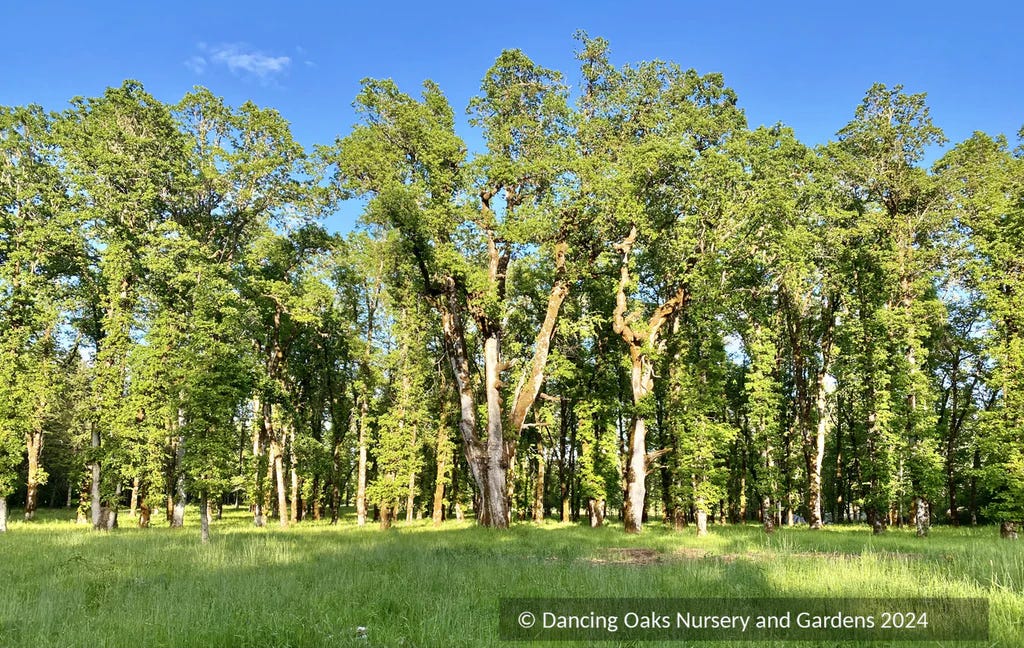The Importance of Oaks in the Willamette Valley
As a follow up to my previous posts about helping our declining bird species, I did a little deep dive into what plants would be most helpful to plant (or protect) in our habitat gardens. At the top of the list: oaks.
Many species of our endangered birds rely specifically on oaks in our ecosystem. The Acorn Woodpecker relies on the acorn itself for food, but also for nesting and storing acorns. The Chipping Sparrow, Western Bluebird, and White-Breasted Nuthatch all rely on the abundant caterpillar species that host on oaks. Oaks support the single most count of insect species in our region. They support an incredible amount of wildlife: mammals, insects, and birds.
Oregon White Oak

Quercus Garryana, the Oregon White Oak, used to be quite common in our area. They have since declined dramatically, largely due to Doug Firs that grow so rapidly that they shade and crowd out the much slower growing white oak.
Oregon White Oak is itself a declining species that has been designated as a tree that needs conservation effort.
The main thing that white oaks require is lots of sun. I planted an oak some years ago in a shadier than optimal spot. It hasn’t grown at all.
They take a variety of soil types, including dry and surprisingly seem to do OK with some flooding. According to Xera, they will tolerate clay as well, which can be one of the most difficult soils to get plants established in.
Oaks can grow quite large, but they do it slowly. There is an area of my property that is suitable for them, once I’ve gotten a handle on the blackberry. However, it isn’t quite suited to large trees. I’m considering planting them anyway, as oaks are a favored source of shiitake mushroom logs, so I can just cut branches or whole trees as needed. I’ll be supporting wildlife and growing food for myself at the same time.
In Clackamas County, oaks are so important in the ecosystem that the Clackamas Soil and Water Conservation District has a program to help fund and maintain oaks on private property. Check with your local Soil and Water Conservation District to see if there are similar programs.
Oregon White Oak Dwarf
If the white oak is too big for you, there is a dwarfing form of this oak called Quercus Garryana var Breweri, growing closer to 6’, which may be a better choice for small spaces. It is naturally common in Southern Oregon. I’m surprised that I don’t see this one offered for sale very often. It appears that Forest Farm has sold it in the past.
Other Oak Possibilities
Though the Oregon White Oak is the best choice for the Willamette Valley, it can be hard to find a sunny and large enough space to fit these in. Given that oaks support the most caterpillar species, it may be worth the time to look for others not necessarily native to the valley. The following species are still native to Oregon, and may be an option for you if you cannot find correct conditions for White Oaks on your site.
Quercus Chrysolepsis, the Canyon Live Oak is an evergreen species of oak also native to southern Oregon. This one accepts a fair amount of shade. I planted one a few years ago in only part sun, and it is about 7’ tall without ever having watered it, and is supposed to pick up speed as it grows. I believe this planting was from Forest Farm. I’ve since planted another, and it was sourced from Cistus.
Quercus Sadleriana, is another oak native to southern Oregon. It is a shrubby, evergreen species that does best with some shade. Cistus appears to have this one in stock.
Quercus Vacciniifolia - the Huckleberry Oak - is found in southern Oregon as well. It is short growing - only a few feet tall.. It seems to enjoy very rocky, steep slopes.
Quercus Kellogii, California Black Oak, is yet another oak native to southern Oregon. It seems to be similar in size and site requirements to our White Oak. It has an incredible fall color.
Donations: the information that is provided here is free for gardeners of all financial means. If you’d like to financially support this site, you can make a one-time donation or monthly subscriptions on this link. All proceeds will fund more garden projects to share here with you, dear readers, thank you! And thank you SO much to the folks that have supported me. Your contributions mean so much.



